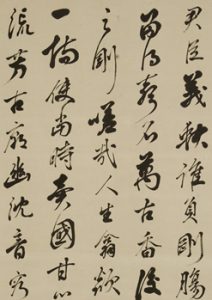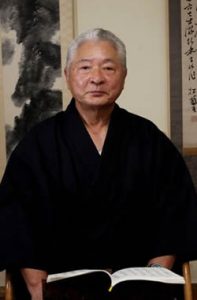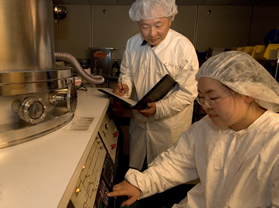Physicist, Opera Singer Encourages Partnerships with World’s Electronic Giants
By Chris Bryant

Dr. Hideo Fujiwara, a University of Alabama physicist, has sung the praises of the campus’ information storage research center to some of the world’s biggest electronic names, but he can frequently be heard singing a different tune.
It’s not that Fujiwara is fickle in his support of UA’s Center for Materials for Information Technology, or MINT. Rather, it’s his enjoyment of “Noh,” the classical opera of his native Japan, that frequently has him singing a melody not often heard in Tuscaloosa.
“It was about 20 years ago that I started to learn classical Japanese opera, or lyric drama, called Noh,” said Fujiwara, who joined MINT in 1992, following a role as deputy general manger of the Hitachi Maxell Tsukuba Research Lab, near Tokyo.
It’s a hobby that seems almost as challenging as the career the physicist has chosen. The typical Noh song is 45 minutes to one hour long, and although he’s been practicing for 20 years, Fujiwara is quick to call himself an amateur. “I am still learning Noh songs through exchanging recorded tapes with my Noh-master and visiting him once or twice a year (in Japan).”
Dr. William “Bill” Butler, director of MINT, said as impressed as he may be with Fujiwara’s singing, it’s his intellect and his contributions to MINT that have his ear.
“Dr. Fujiwara has a detailed understanding of what properties are important to a technology as well as the practical constraints,” Butler said. His understanding of Japanese culture, particularly Japanese business culture, has been invaluable in the Center’s dealings with some of that country’s electronic giants, said Butler.

“I found this Center very good, so I didn’t have any hesitation in encouraging Japanese companies to join our center as a member,” Fujiwara said. Hitachi Maxell and Fujitsu are among MINT’s sponsors that Fujiwara helped recruit. “Sony was already a member when I joined here. Once, they thought about quitting. I tried to keep Sony as a member. They are still here.” MINT’s other corporate partners include IBM and Seagate, and Western Digital recently decided to join.
Fujiwara, whose American friends frequently refer to by his nickname, Ed, said it was a combination of things that first attracted him to MINT, UA’s multi-disciplinary research program that focuses on information storage, including magnetic data storage.
Intrigued by the discovery of a new effect called Giant Magnetoresistance, or GMR, Fujiwara found excitement in the opportunity MINT offered to work in this field. “We knew that it would make almost a revolutionary improvement in the ‘read head,’” Fujiwara said. “I wanted to work in that field, but research on GMR did not fit the Hitachi Maxell business.”
It did fit MINT’s business, and Fujiwara’s belief in the impact of GMR was not overblown, as it led to the rapid development of computer hard drives in the 1990s. The first in a series of revolutionary new “spintronic” devices, the GMR effect is used in almost all disk drives sold today.
Spintronic devices are similar to electronic devices but unlike items such as the transistor, they utilize not only the electronic charge but also another property originating in the quantum nature of the electron called “spin.”

GMR allowed engineers to make sensors that could sense or “read” extremely tiny magnetized regions on a hard drive. This allowed the manufacturers to pack many more bits of information into the same area. The result is well known – cheap hard drives, iPods, TiVos, high capacity memory for digital cameras, and other advancements.
Fujiwara, who has been awarded some 100 patents, half of which are American, won a 2005 Achievement Award from the Magnetics Society of Japan. The recognition was in honor of the significant contributions Fujiwara made in the development of magnetic science during his career.
From an economic standpoint, Fujiwara said his patent that has had the most impact on the industry was one he was awarded for the 1979 development of ferrite heads for VCRs. These heads were composed of two single crystalline ferrite components with specific crystallographic orientations. “It improved the output level of the signal,” Fujiwara said. “Almost all companies in the world used that technology.”
Outside the lab, Fujiwara said he and his wife, Takako, have also found Alabamians to be welcoming.
“Most people are very kind to us. It was very few occasions that I had some problems with others here in Tuscaloosa,” he said.
Fujiwara, who holds master’s and doctorate degrees from the University of Tokyo, said his association with MINT, selected three times by the National Science Foundation as a Materials Research Science and Engineering Center, has been positive.
“Almost from the beginning, I felt comfortable here.”
About MINT: The University of Alabama’s Center for Materials for Information Technology, or MINT, is a multidisciplinary research program focusing on magnetic information storage, including data storage within computers. Since 2001, Dr. William Butler has directed MINT, deemed by the National Science Foundation as one of the 29 Materials Research Science and Engineering Centers in the United States. MINT has continuously carried this designation since it first achieved it in 1994 as one of the 11 centers so recognized in NSF’s original selection. At that time, it was the first such National Science Foundation center in the South and joined Harvard, Princeton, Massachusetts Institute of Technology, Stanford, University of Chicago, University of California-Davis, University of California-San Diego, Purdue, Michigan State and the University of Massachusetts-Amherst. In its 15-year history at UA, MINT has won three Materials Research Science and Engineering awards from NSF. The latest funding, awarded in 2002, was for $6 million to be distributed annually through 2008.
Further Reading